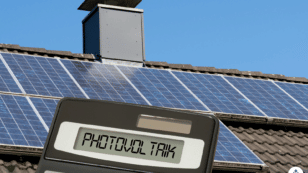
Is Solar Worth It in Ohio? (2024 Homeowner's Guide)
Here’s a quick overview of solar viability in Ohio:
- Ohio ranks 22nd in the country for solar installations.*
- The average electricity rate is 15.85 cents per kilowatt-hour.**
- The average solar payback period is 11 years.***
- Homeowners are eligible for a Solar Renewable Energy Credits (SRECs) Program and the federal solar investment tax credit (ITC).
- The average homeowner saves $32,468 over the lifetime of their solar system.***
*According to the Solar Energy Industries Association.1
**Data from the Energy Information Administration.2
***Calculated assuming the system is purchased in cash.
Each product and or company featured here has been independently selected by the writer. You can learn more about our review methodology here. If you make a purchase using the links included, we may earn commission.
Ohio ranks 22nd in the country for solar adoption, and residents pay less for energy than most people throughout the country. This leaves many Ohio homeowners wondering if going solar will actually save them money. While the answer is usually yes, some homes in the Buckeye State won’t, and determining if your home is right for solar is a crucial first step in converting to this renewable energy source. Below, we’ll discuss the metrics you can use to see if solar will benefit you. We’ll also provide some information on the benefits solar panels bring you and some things you should consider before installing panels on your home.
To speak with an EcoWatch-vetted professional who can help you determine whether solar is worth it for your Ohio home, follow the links below.

Blue Raven Solar
Pros
- Industry-leading in-house financing
- Competitive pricing
- Excellent reputation
Cons
- Doesn't offer solar batteries (coming 2022)

Icon Solar
Regional Service
Average cost
Pros
- Many years of experience
- Comprehensive service offerings
- Great warranty coverage
Cons
- No leases or PPAs

Blue Raven Solar
Pros
- Industry-leading in-house financing
- Competitive pricing
- Excellent reputation
Cons
- Doesn't offer solar batteries (coming 2022)
Watch Below: Learn How Solar Energy Storage Works and Whether It’s Right For You
How to Figure Out if Solar Panels are Worth It in Ohio
Solar panels are a good fit for the majority of Ohioans and save the average homeowner $32,468 after they pay for themselves, but they aren’t right for everyone. Below are some factors you can consider to figure out if solar panels will benefit you and your Ohio home.
What’s Your Home Electricity Consumption?
First, you’ll want to check your home’s monthly energy consumption. Solar panels save money by providing savings on your electric bill, which means the more energy you use each month, the more valuable your panels will be.
The reverse is also true, though, and a good rule of thumb is that homes that consume fewer than 500 kilowatt-hours each month generally aren’t a good fit for solar panel installation. You can check your monthly consumption average on your past electric bills to see if you’re over this benchmark.
The average energy usage in Ohio is around 873 kWh per month, which is right around the national average and puts most homeowners well above the cutoff for solar viability. As such, solar will benefit most Ohio residents based on electricity usage alone.
How Much Is It To Go Solar in Ohio?
The price of solar in Ohio is around $3.19 per watt, which is below the national average of $3.33. Solar equipment is more affordable on a per-watt basis in Ohio than in most other states, and because homes require a smaller-than-average system size of 9 kW, the average total of $20,097 — after the federal tax credit — is also about $1,000 below the national average.
Solar panels provide more value in areas where electricity rates or consumption is high and the most value where both are high. Ohio electricity rates are a bit less than average, and residents use around the average amount of electricity, so solar is just slightly less valuable in Ohio than in many other areas in terms of energy prices and consumption.
However, most residents who convert to solar see them pay for themselves in reduced electric bills in just 11 years and then provide an additional $32,468 in utility bill savings, on average.
What’s the Payback Period for Solar in Ohio?

Most Ohioans will have a payback period between 8 and 14 years. The longer your payback period, the lower your return on investment will be and the longer it will take you to recuperate your investment. Provided your payback timeline is below 25 years, your solar array is still expected to save you money.
What Are Average Buy-Back Rates in Ohio?
Many states now have a mandated net metering program or electricity buy-back program. These programs help solar customers offset and eliminate electric bills, thereby shortening the payback period and bumping up the total ROI. They do this by letting you overproduce electricity and bank the excess for later use at no cost. So, when your panels aren’t producing, like at night or on cloudy days, you can still take advantage of free electricity.
Basically, through interconnection, you can sell excess energy production to your electric company for a credit to your energy bill. Ohio does mandate net metering, but only for investor-owned utilities (IOUs). The rate at which you’re credited is not set, so you could receive a lower credit per kWh hour of excess electricity than you’d pay for the same incoming energy.
Since many customers will not have access to net metering and others will have a less-than-ideal policy available, many Ohio residents opt to install a battery for their system with their panels to help take advantage of all the energy their system produces at a one-to-one ratio. Batteries add between $10,000 and $20,000 to your installation costs, in most cases, so it does drive up your solar pricing, but over time in areas with below-average net metering policies, they often pay for themselves.
Additionally, net metering policies are in decline in other states, most notably California, where NEM 3.0 just decreased the credit rate by around 75%. Overnight, that decreased the value of new solar systems without batteries. New solar customers will likely have to opt to pay more for batteries if they want to see the high ROI possible with net metering. Since Ohio doesn’t have the greatest net metering policy already, it’s very likely that batteries will also be a good investment in the state.
How Much Sun Does Your Roof Receive?
Solar panels require sunlight to produce energy and save you money, so homes that receive abundant sunlight are naturally better suited for solar panel installation. Ohio as a whole experiences around 173 sunny days per year, which is well below the national average of 205 days of sunshine. From a sunlight availability perspective, Ohio ranks relatively low in terms of solar viability.
However, many homeowners still find that there is enough sun to make solar panels a worthwhile investment. You will need to assess your specific home for sun exposure, as every property in Ohio is different. First, you should look for your roof’s orientation, as south-facing roofs in the US are the best for solar panels, and some west-facing roofs are suitable as well. Next, you’ll want to look for shading on your roof from trees or buildings, as any obstruction to your available sunlight will decrease power production and your solar panels’ value.
What’s the Outlook on Solar in Ohio?
Solar power is generally accepted throughout Ohio, but it’s far from the most prevalent renewable energy source. Wind power provides more than half of the clean energy in the Buckeye State, and the solar market is relatively small but continues to grow and expand. The state’s Renewable Portfolio Standard (RPS) goals do specifically require energy to be produced from solar, but it’s just a small portion of the clean energy production goal. Solar installations have increased in numbers in Ohio year over year for the past decade, and utility-scale solar has skyrocketed in the past two years. With generally favorable solar incentives and policies, it’s expected that the solar market will continue to improve, although there’s no guarantee it will ever overtake wind power in the area.
Benefits of Solar Energy in Ohio
Homeowners who convert to solar energy in Ohio will enjoy many benefits that ultimately make switching to this clean energy source more appealing. We’ll discuss some of the most substantial upsides of going solar below.
Electricity Bill Savings
The most significant benefit of converting to solar energy is the savings you’ll enjoy on your electric bills. Solar panels produce energy for your home and let you avoid the rising electricity rates. With most Ohioans paying around $138.37 per month for power, the potential annual savings are $1,660. The energy savings are expected to pay off your system expense in around 11 years and provide additional savings, on average, of $32,468 over the remaining life of the equipment. Your total energy savings could be higher if energy prices continue to rise as they have historically. Installing solar helps you avoid price hikes and budget more accurately.
Lower Taxes & Access to Other Incentives
Although Ohio isn’t the most solar-friendly state, there are some environmental and financial incentives available to residents from both the state and federal governments. One of the most appealing incentives is the federal solar tax credit (ITC), which is a credit to your federal income tax for 30% of your total installation expense. In Ohio, the ITC is typically around $8,613. Some additional Ohio solar incentives are listed below:
- Solar Renewable Energy Credits (SRECs): All solar customers in Ohio will earn SRECs for their power production, with one SREC being afforded for every 1,000 kilowatt-hour (1 megawatt-hour) produced. You can sell SRECs for a profit on the Solar Renewable Energy Certificate market. The average price per credit at the beginning of 2024 in Ohio was $50.
- Solar Sales Tax Exemption: Ohio waives sales tax on all solar equipment and installation fees to reduce the upfront price of going solar.
- Net Metering: Net metering allows you to earn credits to your energy bill for the excess power you send to the grid. It’s only mandated for investor-owned utilities in Ohio, but some other electricity providers opt to provide customers with net metering.
- Energy Conservation for Ohioans (ECO-Link) Program: The ECO-Link Program is a statewide program that makes solar financing more affordable and accessible to all homeowners in the state.
Home Resale Value Increase
An enormous benefit that many solar customers overlook is the bump in home value that solar panels are expected to provide. According to estimates from Zillow, the average property value will jump by around 4.1% with the addition of solar panels. In Ohio, where the typical home is worth around $216,115, most solar customers will enjoy approximately $8,860 in added property value. Your jump in value could be even more significant in more pricy areas, like Cleveland, Cincinnati and Columbus. It’s important to note that this benefit is only available for solar customers who use a solar loan or a cash purchase to pay for their panels. One significant downside to solar leases and power purchase agreements (PPAs) is that they don’t improve your home’s value.
Clean, Renewable Energy
Of course, part of the appeal of going solar is that panels make your home more environmentally friendly. Going solar will reduce your carbon footprint, reduce your reliance on fossil fuels and reduce your contribution to air and water pollution. Solar panel systems will also make you more energy independent, meaning you’ll have less of a tie to your utility company that very likely uses fossil fuels to provide energy.
What to Look Out For When Considering Solar in Ohio
Even after you confirm that solar panels are a worthwhile investment for your home, there are some additional things you’ll need to think about and consider to ensure the best experience possible. We’ll discuss these other considerations below.
Upfront Fees

Payback Period
Your solar panel payback period can help you determine your home’s solar viability, but it will also help estimate your long-term savings and return on investment. The average payback period in Ohio is 11 years, and most residents will have a timeline of between 8 and 14 years. If yours is longer than 14 years, paying more for a solar battery is usually a good idea, as it will often increase your ROI and help recuperate your investment more quickly. Batteries will extend your payback period compared to a panel-only installation with one-to-one net metering available, though.
Net Metering Policies in Ohio
Net metering is mandated in Ohio for investor-owned utilities, but the policy terms can vary between electric companies. Additionally, some municipal utility companies and electric cooperatives choose to provide net metering. Before you commit to solar panels or sign anything, it’s a good idea to check with your electric company about the available net metering policy and terms.
Keep in mind that net metering is being downgraded in a lot of other states, and the likelihood is that it will eventually disappear in Ohio, even though there’s no current plan for that to happen. If and when it does get discontinued, solar batteries will likely be necessary if you want to eliminate your electric bill with your solar panels. Batteries bump up installation costs by up to $20,000 or more, so going solar now and locking in even a lackluster NEM rate is probably going to be more cost effective than waiting until the policy is no longer available.
Pending Policies & Changes to Incentives
As the solar industry in Ohio and the country continues to expand and improve, policies and incentives will naturally be affected. The policies mentioned above could change, new rebate programs could be added and existing incentives could disappear in the future. It’s usually not advisable to wait for better incentives to pop up, but you should do some research for updates to policies and incentives before converting to solar.
Weather & Climate in Ohio
Solar panels are most efficient and most valuable in states closer to the equator, where sunlight is most intense and abundant. Many residents worry that the northern location of Ohio will make solar a poor investment and that the long, frigid winters will kill efficiency. However, electricity travels more quickly in the cold, so efficiency can still be quite good in the winters. Some residents also worry about the below-average sunny days in the area and the potential for extreme weather. The cloudy days in the area can drop efficiency to as little as 10%, but the state receives enough sunlight to make solar a good investment still for most homeowners. The extreme weather and lake-effect snowstorms can be concerning as well, but opting for a solar installer than provides a good warranty is often enough to put residents’ minds at ease.
Companies Pushing Solar Leases or PPAs
Finally, you will need to consider carefully the solar panel installation you want to complete the work for you. Some companies in Ohio advertise “free panels for life” or push solar leases that look like a good deal. Unfortunately, free panels are never really free, and they’re usually just solar leases in disguise. Solar leases are worse than solar loans for most people, as they don’t let you take the federal tax credit, they don’t increase your home value and they provide far fewer savings in nearly every case. Unfortunately, the local news station, 10 WBNS, has reported on solar scams throughout Ohio, including customers who are lied to about government tax incentives and rebates and end up paying more after solar installation than they did before.3 Duke Energy has also had to warn customers about door-to-door solar scams that leave people with high payments and minimal savings on their electric bills.4
Wrap Up: Is Solar Worth it in Ohio?
Solar panels are a great investment for most Ohio homeowners, saving most solar customers in the state a significant amount of money after the panels pay for themselves. However, solar conversion isn’t ideal for every home, so confirming that your property is a good candidate for solar installation is crucial before you make any decisions. Some things to keep in mind that can affect the value of your solar panels include your average monthly electric bills, your home’s energy efficiency, the size of the solar power system you need and the direction your roof faces.
There are additional considerations to make as well, like the net metering policy that’s available to you, especially since the policy is in flux in other states. As such, we strongly suggest contacting a reputable solar installer in your area to help you determine if solar is right for you.
See also: Calculate how much you can save by going solar
Read More About Going Solar
- What Are the Best Solar Companies in Ohio?
- What Solar Incentives Are There in Ohio?
- What Is the Cost of Solar Panels in Ohio?
The cost information presented in this article is derived from a comprehensive analysis, incorporating data from multiple industry sources. The average cost per watt per state was calculated based on figures from Consumer Affairs, Energy Sage, and Berkeley Lab’s Electricity Markets & Policy Department. Additionally, monthly energy consumption and the average monthly cost of electricity were sourced from the U.S. Energy Information Administration, ensuring a well-rounded and accurate representation of the information presented.
Frequently Asked Questions
The EcoWatch team gets questions about the potential of solar panels in Ohio all the time. We’ll include some of the questions we see most often below, along with our responses. If you have specific questions that aren’t answered here, reach out to our team of solar experts at solar@ecowatch.com.
The average solar panel payback period in Ohio is around 11 years, which is in line with the national average. Most Ohio homeowners have an estimated payback period between 8 and 14 years. However, your timeline could fall outside of this standard window. Some things that affect your payback period are your average monthly energy consumption, the system size you need, shading on your property, and more. You can use a solar calculator to estimate your payback period or have an experienced solar company calculate it for you.
In most cases, yes, solar panels will save you money in Ohio. However, you do need to make sure that your home is a good fit for solar, which you can do using the guide above. The average Ohio homeowner spends around $138.37 per month on electricity. If you can eliminate your electric bills — which usually require a good net metering policy or a solar battery — you stand to save around $1,660 per year on your utility bills. The average solar customer in Ohio will pay off their system expenses using these savings within 11 years, after which the typical savings is around $32,468.
Yes, solar panels will increase your home value in Ohio, provided you purchase them with cash or a solar loan. The average property will jump in value by around 4.1% when a solar energy system is installed, according to Zillow. In Ohio, this averages out to around $8,860 in added value. Ohio does not have a solar property tax exemption, so your property taxes will go up a bit in response.
Yes, permits are a requirement for all Ohio solar panel installations and connections to the electric grid. Permits help your local municipality confirm that the work is done safely and according to code. In most cases, your solar installer will handle the permitting process for you.
You can complete DIY solar panel installation in Ohio, but it’s strongly recommended against. Installing a rooftop solar system is quite dangerous, and mistakes during the process could leave you with severe roof leaks and property damage. It’s best to leave the installation process to a trusted and experienced solar installer in your area.
Top Solar Installers in Ohio Cities
Comparing authorized solar partners
-
- Industry-leading in-house financing
- Competitive pricing
- Excellent reputation
- Doesn't offer solar batteries (coming 2022)
A+Best Solar Financing2014Trina Solar, Canadian Solar, SolarEdge, Silfab, SunPower25-year manufacturer warranty; 10-year workmanship warranty, 2-year production guarantee
Having trouble deciding? Click below and use our process to receive multiple quotes instead:

 233k
233k  41k
41k  Subscribe
Subscribe 







